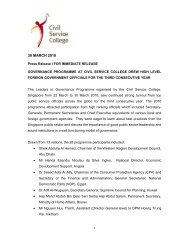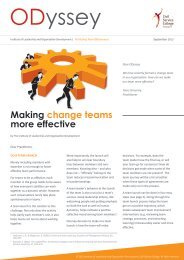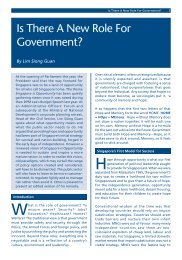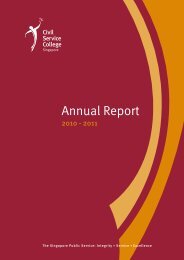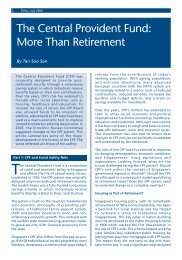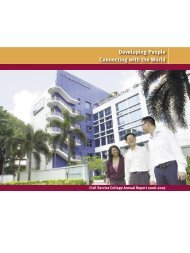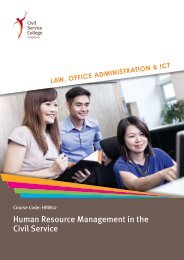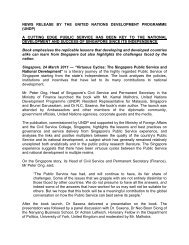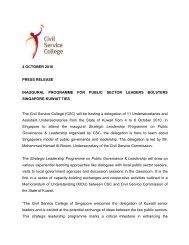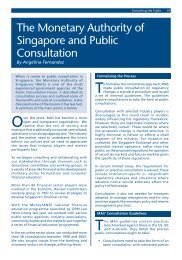Public Consultation Toolkit - Civil Service College
Public Consultation Toolkit - Civil Service College
Public Consultation Toolkit - Civil Service College
You also want an ePaper? Increase the reach of your titles
YUMPU automatically turns print PDFs into web optimized ePapers that Google loves.
<strong>Public</strong> <strong>Consultation</strong> <strong>Toolkit</strong> 69 70 <strong>Public</strong> <strong>Consultation</strong> <strong>Toolkit</strong><br />
of the surveyor and the public setting may compel the participants to respond in a certain<br />
manner and bias the survey results.<br />
b) Telephone survey<br />
• When is it useful?<br />
Telephone surveys are useful for general attitudinal surveys. Agencies can explore options<br />
with participants and assist them with unfamiliar words or questions. This method yields fast<br />
results, and has a higher response rate than mailed-in surveys.<br />
• Considerations<br />
Although to a lesser extent than in-person survey, the tele-surveyor may still compel the<br />
participants to respond in a certain manner and bias the survey results. For this method to<br />
work successfully, officers must be trained to handle questions and different personalities<br />
over the phone sensitively and objectively. Depending on the profile of the target audience,<br />
surveyors may need to be proficient in different languages.<br />
c) Mailed survey: Surveys can be mailed to the home or organisation addresses of the target<br />
audience.<br />
• When is it useful?<br />
Mailed surveys can reach a large geographical location and are less labour-intensive than<br />
in-person or telephone surveys conducted. Participants can complete the surveys at their<br />
convenience and in private; hence it is suitable for sensitive issues.<br />
• Considerations<br />
It is harder for participants to seek clarification for mailed surveys. This method is limited<br />
to literate members of the public and requires an up-to-date address list. There also tends<br />
to be a lower response rate for mailed survey because it requires participants to take the<br />
additional step of returning the surveys to the agencies.<br />
d) Internet survey: E-mail and online surveys (distributed through a website link) are the key<br />
forms of internet surveys. Links explaining different terms or concepts can also be provided<br />
online to provide more comprehensive information. Data is automatically entered into a<br />
database and can be automatically analysed or exported to other software programmes.<br />
When is it most useful?<br />
<strong>Public</strong> forums are useful for policy issues that affect a large proportion of the public. The forums<br />
can be used to educate stakeholders about the policy and obtain general feedback. <strong>Public</strong><br />
forums are typically less useful for gathering in-depth feedback from specific stakeholders.<br />
Considerations<br />
<strong>Public</strong> forums carry the risk that the agenda may be dominated by interest groups or vocal<br />
individuals. This is particularly the case if the policy or initiative being consulted is sensitive or<br />
emotive.<br />
5. Blogs<br />
A blog (a contraction of the term ‘web log’) is a website<br />
that usually contains informal commentaries or personal<br />
opinions about a subject. Feedback functions in the blogs<br />
allow the public to provide comments and responses to<br />
the information posted. Agencies also have the option of<br />
embedding their blog on the agency’s website. The blog page<br />
can then be easily updated either through the website or<br />
through applications on mobile devices.<br />
Through this medium, agencies or public figures such as<br />
Ministers can ask the opinions of blog readers on a specific<br />
subject or test the reaction of blog readers towards a certain<br />
topic. This can allow the government to conduct informal<br />
or “soft” consultation with the public. In addition, the<br />
contributor(s) can also provide an insider’s perspective on<br />
various policies (e.g. tax) and events (e.g. National Day). Such<br />
posts allow the public to relate to the government on a more<br />
personal and informal level.<br />
The main distinction between the government’s website<br />
and blog posts is that the website provides comprehensive<br />
information, while blog posts provide snippets of information<br />
– summaries, opinions, circumstances and reasons<br />
surrounding various policies and principles. Typically, blogs<br />
present the contributors’ personal perspectives.<br />
The target audience of blogs are technologically-savvy<br />
individuals.<br />
How it works<br />
A typical blog combines text, images, video and links to other<br />
blogs or websites. An account is first created at a blog website<br />
(e.g. blogspot.com). The blog page can be personalised, or<br />
selected from a template, and finally, the contributor can<br />
begin sharing content online.<br />
TIPS FOR<br />
EFFECTIVENESS<br />
• Keep blog posts<br />
interesting – readers are<br />
keen to explore issues on a<br />
personal level.<br />
• Short posts are fine if timeconstraints<br />
are present.<br />
The key is to be consistent<br />
between time spans of<br />
blog posts.<br />
• ‘Tag’ entries according to<br />
different categories, so that<br />
readers may be able to<br />
search for similar topics on<br />
the blog.



